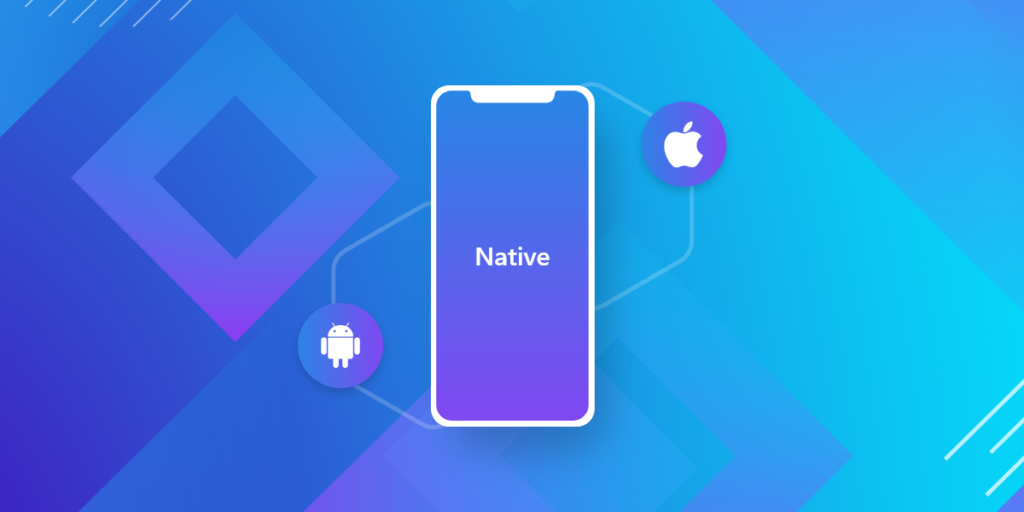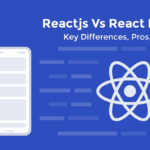Mobile devices have long become an indispensable part of our lives. Since landline phones gave way to mobile ones, everything has gone beyond mere communication.
We browse the Internet for the latest news and exciting articles, share our travel impressions on Facebook and Instagram, book hotels, buy tickets, stream and watch videos, and whatnot. For all these activities, we need robust, stable products.
The expansion of mobile devices has caused a major change in the way we do business. Enterprises and SMEs are striving to get innovative mobile solutions to stay competitive.
But there are serious issues to consider, though. For example, compatibility. People use versatile devices, and those run on different platforms.
To address vast audiences, you should decide on the most effective approach to build your product. The principal dilemma here is “native vs. cross-platform”. Which of them suits your goals better?
Let’s consider the key features of these approaches and single out important aspects of cross-platform development.

Post Contents
Building Native Apps
At first glance, the native approach seems a winner. It’s like in everyday life: if you wish to get a reliable appliance, device, or machine, pay attention to those built for specific purposes.
Specialists think over such products considering each detail, and their performance leaves end-users impressed.
Thus, professional photographers still use DSLR cameras as their capacities excel over those of an average smartphone.
Multipurpose desktop speakers cannot compete with high-end audio systems, and so on.
The same attitude applies to mobile apps: if they are designed for certain devices, they have all the necessary functionality and imply all potential scenarios of use.
An app tailored for iOS or Android usually performs better, has stable access to hardware, and offers end-users a pleasant intuitive interface.
If a person uses a certain ecosystem (a MacBook, an iPhone, and an iPad), they will quickly figure out how their new Apple device works and find pleasure in dealing with it.
Everything is thought out down to the smallest detail – just use it.
Nevertheless, building such apps demands more resources, both human and financial.
Keep this in mind when resolving the dilemma of “native app development vs. cross-platform approach”.
Programmers have a special tool set when working on native solutions. For instance, Swift is meant for iOS devices and Kotlin opens great possibilities when working with Android apps.

The Meaning Of The Cross-platform Approach
With the native approach, you will yield impressive results. But in our rapidly changing world, versatility often wins over exclusiveness.
It helps professionals to keep up with changing requirements and plunge into numerous activities no matter the situation and tool set. Here is where you can clearly see the benefits of cross-platform development.
IT specialists choose cross-platform frameworks to build mobile apps that would run on various operating systems.
Instead of creating separate solutions for iOS, Android, or another OS, they develop all-purpose programs.
The code for such apps is created once but can be applied on numerous occasions when introducing important changes.
This allows businesses to cut expenses on software development significantly and engage fewer professionals in the whole process.
To arrive at a sane decision, entrepreneurs must research the actual state of affairs in the digital market.
As of December 2022, Apple was the major mobile vendor in the US, with a share of 55.85%. Samsung was the runner-up, with 29.85%.
Even though Apple devices make up more than half of the mobile market in this country, there are gigantic audiences left unaddressed if companies concentrate on iOS development only.
So, it’s you who decide here: either you create unique products for separate target groups or create one that would run on different platforms.

Major Benefits Of Cross-platform App Development
1.) An Impressive Number Of Users
This advantage of cross-platform development is, perhaps, the most obvious. With it, you will build digital solutions that consider different user groups. Your potential customers may use iOS, Android, macOS, Windows, etc. – you appeal to all of them simultaneously. As a result, your products or services will be available to many more people than with just one native app.
2.) Lower Expenses
When writing a multipurpose program, you needn’t engage two or more teams to work on separate products.
One development team with the relevant skill set will carry out all tasks, including maintenance and support. This means you are saving on salaries.
3.) Common Reusable Code
Developers use the code several times. This results in a considerable shortening of the development process.
As IT professionals don’t need to rewrite pieces of code, they just deploy the existing ones on various platforms.
Such an attitude is known as WORA, which stands for “Write Once Run Anywhere”.
4.) Comfortable Deployment And Subsequent Support
For developers, it’s much easier to deploy code and carry out necessary tasks while maintaining a product.
Experts reconcile changes between iOS, Android, and other platforms much more quickly and efficiently.
5.) Recognizable UI
A cross-platform application looks and operates similarly on any device, be it an Apple iPhone, a Samsung Galaxy Tab, or anything else.
So, end-users won’t have difficulty switching between various devices when performing habitual tasks.
No matter some platform-specific features, the core is identical. UX is also of comparable quality.
6.) Rapid Development And Release
You only build a cross-platform product once. One development cycle is enough, any updates are rapid as well.
This allows you to save time and release your product faster. One more important point: you start getting profit from your software solution much earlier.
The above benefits of cross-platform development are enticing. But don’t forget about potential risks.

Key Disadvantages
1.) Performance Issues
In most scenarios, you won’t notice the difference between a native app and a cross-platform one.
However, some tasks they perform imply enhanced productivity. As the code of such an app has both native and non-native elements, this might somewhat slow down the overall performance.
2.) Issues With UX
Not all native UI elements are supported. You may have difficulty interacting with an app, it may seem alien to a certain extent.
3.) Functionality Issues
With a native app, working with the camera, microphone, or GPS is pleasant. Unfortunately, there may arise certain issues here when dealing with cross-platform technologies and frameworks.
Cross-platform Technologies: Do You Need Them?
To decide on this, just ask yourself some basic questions. What user concerns does your product address?
When exactly do you need to release it? Will it work under increased load or be regarded as an additional tool? Below, you will find some useful tips.
You will definitely profit from the advantages of cross-platform development if:
- Your primary intent is to appeal to many consumers and find audiences in different countries.
- Your product must rapidly hit the market, and any delay is out of the question.
- You strive to prove the efficiency of a software idea on an MVP. But you have to cut time and want to invest little money. The meaning of cross-platform techniques involves reducing any expenses.
- The product you are working on is quite simple and doesn’t require enhanced computing capacities or excessive animation.
- You build a mobile app as an addition to your website and don’t want to spend much on this extra product.

If your business is searching for a feature-rich digital solution, think about the native approach instead of cross-platform technologies.
It opens up more opportunities for growth if you require an aesthetically pleasing and complex app that is supposed to operate around the clock.
Some Widespread Cross-platform Programming Languages
Now you are aware of the meaning of the cross-platform approach. If this is your choice, the next step is defining the appropriate language. Pay attention to the following ones.
JavaScript
This language appeared in 1995. Over more than 25 years, IT experts have implied it to a variety of products.
JavaScript has a robust community; it has earned trust and recognition among leading IT professionals.
Although JS is primarily used for website development, it is perfectly suitable for creating cost-efficient apps that would operate on different platforms.
Its compatibility with third-party frameworks, versatility, and clarity while learning and mastering make it a top choice.
Its UI mechanism reminds those of Android and iOS apps. Professionals can reuse native code when building software solutions with JS.
Thus, JS allows both professionals and beginners to fully enjoy the benefits of cross-platform development.

Java
This language can also boast of a long and glorious story of success. Since 1995, specialists have been choosing it for mobile app development.
The WORA approach works perfectly with Java: solutions written in it seamlessly run on different operating systems.
Compiled Java code doesn’t demand recompiling as it efficiently operates on each Java-enabled platform.
This language competes in popularity with JavaScript. Beginners say it is learning-friendly, which allows them to acquire the necessary knowledge quickly and delve into programming, be it building Android apps or powerful servers.
Kotlin
Kotlin first appeared in 2011. Since then, it has proven a reliable tool for developing software of any complexity.
In 2019, Google named it the first language of choice for building Android apps.
It works perfectly with Java as its creators provided for their full interoperability and interchangeability. Among Kotlin’s benefits are simple code and upright syntax.
Leading companies across the globe resort to it on their projects. For example, Google, Amazon, and Shazam used it during backend development.
Barclay’s Bank opted for this language for web services. Among other world-known businesses profiting from Kotlin are Netflix, Pinterest, Uber, Coursera, and Duolingo.
This efficient language allows you to reveal the meaning of the cross-platform development concept to a nicety.
C#
Microsoft introduced the object-oriented C# in 2000. It allows for a great level of independence when developing digital products.
Programmers needn’t turn to Swift or Java when working with it. The scope of solutions you can write in C# is quite vast.
These are mobile, web apps, and desktop solutions. Game developers highly appreciate it, that’s why you can find a variety of video games for computers and consoles written in C#.
Such renowned products as Adobe Photoshop and Mozilla Firefox were developed with C#. Great evidence of its efficiency, right? With it, you’ll discover the advantages of cross-platform development in full.
Dart
Google first introduced Dart in 2011. Since then, programmers have been writing server and desktop apps in it and building robust web and mobile solutions. It is extremely popular among IT professionals.
Students taking programming courses mention that Dart is easy to perceive and master.
You can compile Dart to JavaScript or machine code. It is also fully suitable for server-side and client-side app development. You needn’t change Dart scripts for native iOS and Android apps.
Objective-C
It is another good choice as it also supports cross-platform technologies. The oldest one on our list, this language first appeared almost four decades ago, in 1984.
For a long time, Objective-C was a standard for such Apple platforms as macOS, iOS, etc. It has proven as a solid tool that makes it possible to develop scalable efficient apps.
The language has been operating for many years now, which is solid proof of its maturity and reliability.
Currently, its younger rival Swift is gaining more popularity in the Apple community. But you can still use that old proven language on your projects.
Wrapping up
“Native vs. cross-platform” – this debate is still alive. No article on the Internet will give you an ultimate answer, which of them is more appropriate for your cross-platform development company.
Businesses pursue different goals, possess various funds, and cannot allocate their budgets identically.
Contemporary society cherishes versatility and diversity. Under such circumstances, the meaning of the cross-platform approach seems symbolic.
Sometimes, you cannot spend months or even years developing an exclusive app for each specific platform.
If you choose cross-platform technologies, such a step will enable you to keep up with the pace of tech advances, save considerable resources and be flexible.
You won’t even risk compromising the efficiency of your future solution when setting off on this exciting journey. Cross-platform applications have long proven powerful.






























